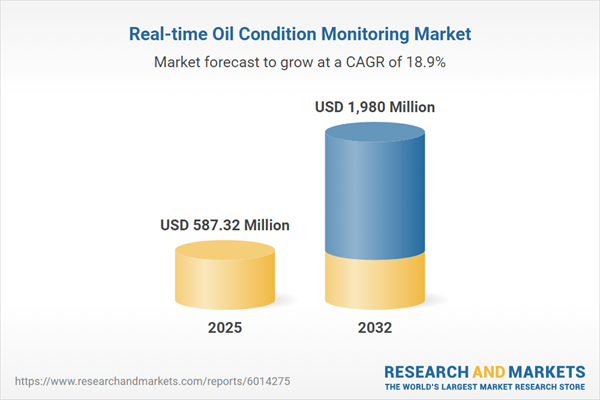Speak directly to the analyst to clarify any post sales queries you may have.
The real-time oil condition monitoring market is transforming industrial asset management, enabling businesses to maximize equipment reliability while improving cost efficiency. As decision-makers pursue advanced predictive maintenance, these solutions offer immediate, actionable insights that elevate operational performance and support digital transformation strategies.
Market Snapshot: Real-Time Oil Condition Monitoring Market
The real-time oil condition monitoring market grew from USD 497.81 million in 2024 to USD 587.32 million in 2025. It is projected to register a CAGR of 18.89%, reaching USD 1.98 billion by 2032. This robust growth reflects expanding demand for continuous lubrication oversight across key industrial sectors, fueled by the urgency to prevent equipment failures and comply with evolving standards.
Scope & Segmentation
- Technology: Offline monitoring such as laboratory analysis and portable analyzers; online monitoring covering cloud-based analytics and IoT-based monitoring solutions.
- End User Industry: Industrial applications including manufacturing and oil & gas; power generation encompassing nuclear and thermal installations.
- Equipment: Engines such as diesel and gas, alongside gearboxes including reduction and transmission types.
- Oil Type: Mineral oils and synthetic formulations, with further segmentation into ester and polyalphaolefin (PAO) blends.
- Sensor Type: Particle counting methods using light blocking or light extinction, as well as viscosity measurement via falling ball and vibrational technologies.
- Geography: Americas (United States, Canada, Mexico, Brazil, Argentina, Chile, Colombia, Peru), Europe, Middle East & Africa (United Kingdom, Germany, France, Russia, Italy, Spain, Netherlands, Sweden, Poland, Switzerland, UAE, Saudi Arabia, Qatar, Turkey, Israel, South Africa, Nigeria, Egypt, Kenya), and Asia-Pacific (China, India, Japan, Australia, South Korea, Indonesia, Thailand, Malaysia, Singapore, Taiwan).
- Leading Companies: ABB Ltd., Emerson Electric Co., General Electric Company, SKF AB, Parker-Hannifin Corporation, Baker Hughes Company, Siemens AG, Endress+Hauser AG, Yokogawa Electric Corporation, Fortive Corporation.
Key Takeaways
- Adoption of real-time oil condition monitoring solutions is a crucial driver of operational efficiency, providing maintenance teams with continuous data to inform condition-based interventions.
- Digitalization trends, including the integration of IoT sensors and cloud-based analytics, are streamlining asset management and reducing reactive maintenance incidents.
- Industries in regulated environments, such as power generation and petrochemicals, prioritize advanced monitoring for compliance with environmental and safety standards.
- Outcome-based service contracts are becoming prevalent, reflecting a shift from capital expenditure to performance-driven agreements that align provider incentives with end-user reliability goals.
- Market penetration varies regionally, with North America and Europe leading in the adoption of centralized cloud platforms, while Asia-Pacific demonstrates rapid uptake of modular, scalable monitoring architectures.
- Strategic partnerships between technology developers and regional manufacturers facilitate localized production and deployment, helping to maintain access to innovative solutions amid evolving trade conditions.
Tariff Impact: Navigating Trade and Sourcing Shifts
Recent United States tariff policies are prompting manufacturers to optimize sourcing, emphasizing regional suppliers and accelerating nearshoring in North America. These dynamics have led to higher equipment acquisition costs and increased adoption of bundled service models. Partnerships with local fabricators and technology collaborators are mitigating supply chain risks, ensuring uninterrupted operations across complex industrial settings.
Methodology & Data Sources
This report draws on a combination of primary interviews with maintenance professionals, lubrication engineers, and technology architects, backed by surveys of reliability specialists. Secondary research incorporated technical papers, regulatory documents, and corporate disclosures. Analytical rigor is ensured through scenario-based modeling and expert-led validation workshops.
Why This Report Matters
- Enables executives to benchmark technology strategies, understand regulatory influences, and assess new partnership opportunities.
- Delivers actionable insights into evolving pricing models and competitive positioning under shifting trade and policy pressures.
- Supports integration of advanced monitoring within broader enterprise asset management and sustainability frameworks.
Conclusion
Real-time oil condition monitoring is reshaping industrial maintenance by unlocking new predictive capabilities and supporting regulatory alignment. Strategic adoption will position organizations at the forefront of operational reliability and digital innovation.
Additional Product Information:
- Purchase of this report includes 1 year online access with quarterly updates.
- This report can be updated on request. Please contact our Customer Experience team using the Ask a Question widget on our website.
Table of Contents
3. Executive Summary
4. Market Overview
7. Cumulative Impact of Artificial Intelligence 2025
Companies Mentioned
The companies profiled in this Real-time Oil Condition Monitoring market report include:- ABB Ltd.
- Emerson Electric Co.
- General Electric Company
- SKF AB
- Parker-Hannifin Corporation
- Baker Hughes Company
- Siemens AG
- Endress+Hauser AG
- Yokogawa Electric Corporation
- Fortive Corporation
Table Information
| Report Attribute | Details |
|---|---|
| No. of Pages | 188 |
| Published | November 2025 |
| Forecast Period | 2025 - 2032 |
| Estimated Market Value ( USD | $ 587.32 Million |
| Forecasted Market Value ( USD | $ 1980 Million |
| Compound Annual Growth Rate | 18.8% |
| Regions Covered | Global |
| No. of Companies Mentioned | 11 |









